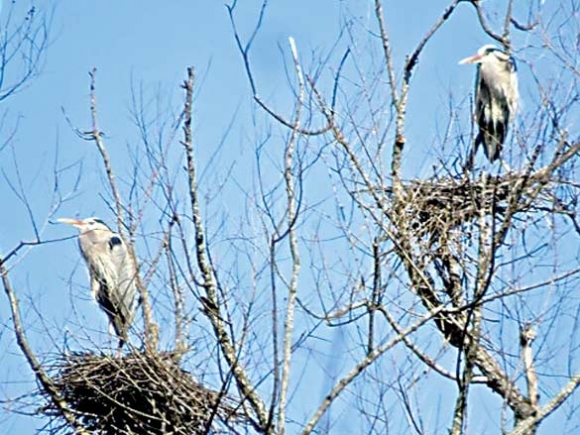The Naturalist's Corner: Today’s pterodactyl

A low guttural croak comes out of the fog hanging over the French Broad River. I turn and look towards the noise. A silhouette starts to form. I can see the shadowy outline of a large head and beak. Long wide wings row through the fog and long legs trail behind.
I know, immediately — it’s a pterodactyl — no, wait, that was 150 million years ago. It’s one of the pterodactyl’s relatives, a great blue heron. I don’t know what I could have been thinking; herons have only been around for 60 million years or so. But if you’ve watched great blues flying overhead, notions of those ancient flying dinosaurs are easy to come by.
The great blue heron is the largest heron in North America. It can reach nearly 4.5 feet tall. It has a wingspan of nearly 7 feet and weighs about 8 pounds. The great blue gets its name from it’s primarily blue/gray plumage. It has a wide black stripe over its eye giving its face a black and white appearance. The tops of its wings are two-toned, pale on the forewing (top) with darker flight feathers. In flight the great blue is easily distinguished from cranes and/or swans by the fact that it flies with it’s neck curved in a tight “S” and its head hunched back against its body. There is a white subspecies of great blue — the great white heron, found primarily in coastal Florida.
This feathered dinosaur feeds primarily by wading slowly in shallow water prepared to instantly strike out with its sharp pointed beak to grab fish, amphibians, reptiles, crustaceans or just about anything else that moves within range. They are not above stalking on terra firma where voles become preferred prey. Special vertebrae in the great blue heron’s neck (the same ones that allow it to fold its neck back while flying) act like a spring when the heron thrusts at prey.
Another adaptation of great blue herons is specialized feathers on its breast. These feathers known as “powder down” continually grow and fray. The heron combs the powder down with a fringed claw on its middle toes and/or rubs them with its beak then uses the powder to clean fish oils and other slime from its feathers and protect them with an oily coating.
According to Birds of North Carolina, great blue heron numbers have increased significantly across the state since the 1980s. The great blue heron is clearly the most common large wader in the mountains and is a year-round resident. I don’t think you could bird Lake Junaluska two days in a row during any month of the year without seeing a great blue. I know they nest along the Pigeon River and there are nesting reports from Transylvania, Jackson and Cherokee counties.
Related Items
Great blues generally nest in small colonies called heronries rather than the large rookeries of other wading birds. In coastal areas heronries can grow up to 500 nests — but much smaller numbers are more common. And unlike rookeries, which normally contain different species, great blue heronries are normally exclusive — occasionally adjacent to other herons. These heronries are usually high up in trees in standing water, but great blues have been known to nest on the ground if there are no suitable trees around.
A couple of weekends ago, on the way home from Knoxville, my wife and I made a quick side trip to Rankin Bottoms Wildlife Management Area near Erwin, Tennessee This swampy backwater never fails to make this ole Loosiana heart flutter. And on this quick pass we were delighted to find an active great blue heronry with about a dozen active nests. It’s always a treat to see this modern day pterodactyl.
Don Hendershot is a writer and naturalist. He can be reached at This email address is being protected from spambots. You need JavaScript enabled to view it..









